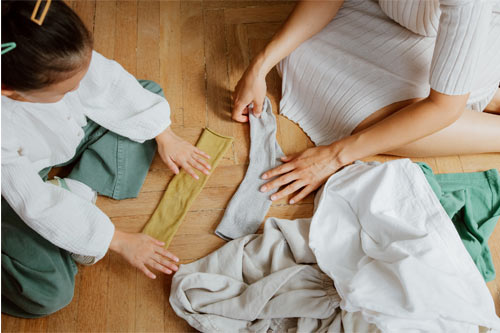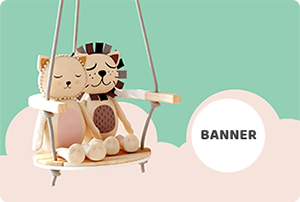
Chores and Kids
It is not what you do for your children, but what you have taught them to do for themselves that will make them successful human beings.”
Ann Landers
Chores – We grew up despising that word. And now our kids do? However, as Pediatric Occupational Therapists (OTs) who support children with their functional and meaningful daily tasks, we know the benefits of chores are numerous. From sensory input to sequencing – developmentally appropriate chores have it all.
This blog post will list out chores that are appropriate for each developmental age, their benefits, how to help children become more independent with chores and how to reframe the idea of chores to make them a more rewarding and positive experience for all children.
Benefits of Chores:
We wouldn’t be OT’s if we didn’t first talk about chores and how they relate to ‘Activities of Daily Living’ or ADLs. ADLs is a term commonly used by OTs which refers to the meaningful everyday tasks that a person engages in to have a successful life. These include bathing, getting dressed, feeding etc. Instrumental Activities of Daily Living or IADLs, on the other hand, are similar to ADLs, except that these tasks require more complex and higher level skills to complete. Although they may not be essential to basic survival such as eating and bathing, they are still important to have meaningful engagement in the world. Examples of IADLs are: home management, meal preparation, etc. Therefore, teaching children to become more independent with chores sets them up to have meaningful engagement in the real world.
Learning how to do age-appropriate chores not only helps to foster independence and accountability but also helps children work on many skills such as their fine, gross and visual motor skills, bilateral coordination, language development, sensory input, sustained attention, sequencing, organizational skills and more – all skills they will need to success in the school environment as well.
Now let’s break down the specific skills mentioned above and how they can be acquired by engaging in chores (you may also find the italicized words in our glossary section):
- Sensory Input – Doing chores can provide a lot of sensory input especially for children who seek movement, touch, visual stimulation and even auditory stimulation (ex listen to the sound of a spray bottle squirting water or the rag wiping left to right). One sensory input, in particular, that is enjoyable to children who either seek and/or avoid sensory stimulation is called proprioception – and a type of proprioceptive input that can be achieved through chores is categorized as ‘heavy work activities’. Heavy work provides a calming and organizing effect on a child’s body when they receive deep pressure in their joints by carrying, lifting, pulling and/or pushing items. This can be achieved by carrying a laundry basket filled with clothes, vacuuming, and even putting groceries away.
- Gross motor skills: Lifting, transferring and coordinating the body to complete chores works on strengthening a lot of the larger muscles of the body.
- Bilateral Coordination – Using both hands to lift, manipulate and transfer items allows both sides of the body to work in a coordinated and organized manner.
- Fine motor skills: Many chores work on strengthening the finer muscles of the hands which is especially important for handwriting. Examples include pressing down on a spray bottle, wiping spills, hanging laundry with clothespin, etc.
- Visual motor skills: Seeing where the “mess” is and coordinating body movements to clean up the mess allows the eyes and body to work together, a skill that is essential for tasks like cutting.
- Tactile input/ tactile desensitization: Many household cleaning materials such as rags, mops, dusters come with various textures. Encourage your child to explore and become more normalized with touching different textures to prevent tactile sensitivities.
- Attention and Sequencing: By completing chores, children have to visually attend to the task until it’s complete and follow a sequence of steps. This helps work on increasing their attention span and sequencing skills.
- Language: Encourage your child to learn the names of various cleaning items, practice identifying the properties of the objects, practice social skills of turn taking and following directions.
Chores by Developmental Age
Before I talk about ways to help children become more independent with chores and have a positive outlook on these tasks – here is a list of chores that are appropriate for your child based on their developmental age:
2-3 year old
- Put dirty clothing in washing machine
- Wipe small spills
- Water plants
- Help make bed
- Help dust
4-5 year old
- All previous chores
- Match socks
- Sort/put laundry away
- Help set dinner table
- Make the bed
- Wipe tables
- Sweep with small broom
6-9 year old
- Sweep floors
- Organize toys
- Sort silverware
- Fold laundry
- Put away groceries
- Take out trash
10-12 year old
- All previous chores
- Wash dishes
- Mop the floors
- Clean toilet
- Clean out the car
- Meal prep
- Do the dishes
12 + years
- All previous chores
- Supervise younger siblings
- Cook meals
- Wash windows
- Help grocery shop
- Iron clothes
- Mow the lawn
- Help with simple home repairs
Helping Children Become More Independent with Chores:
- It is important that chores are developmentally appropriate for your child’s age (see chart above) for safety purposes and also for the just-right-challenge (a task that is not too difficult but challenging enough to promote learning).
- Children can do chores long before they can talk about it. Since children learn by first seeing, modeling how to complete the chore is important when demonstrating how to safely use the equipment and coordinate the body movements.
- There are different types of supports or cues to provide your child (ie physical, verbal, visual, etc). When providing physical support, place your hand under or over the child’s hand to guide them through the action of completing the chore. When providing visual cues you can place a sticker on the part of the broom stick, for example, where your child’s hand should be placed and/or mark the spot on the floor where they should collect the scraps of paper on the floor with their broom. Verbal cues can be given as well (ex: “Use both hands to hold the broom, move in a side to side motion etc). Gradually diminish any and all cues provided as your child learns to become more independent with the given task.
- Remember to not teach them these skills when in a rush. Practice takes time.
- Understand that there may be a cultural component to completing chores.
Making Chores More Pleasurable:
Many children view chores as a undesirable and time wasting task. Here are ways to change that perspective:
- Consider describing and engaging in chores with the “growth mindset”. In other words, children should perceive difficult tasks as something beneficial and important to their wellbeing. For example, instead of thinking “ugh, I have to clean up my room” – think “I deserve to have a clean room so I can be safe and find everything I need.”
- Consider framing chores as a way in which you are doing your job to help the family versus a punishment when doing something wrong.
- As an adult and model figure for your child, always check to make sure your own views and statements on chores are seen in a positive light. For instance, while washing the dishes, if you appear upset or bothered, this portrays the idea of washing dishes as something dreadful. However, if you verbalize in front of your child how great it feels to have clean dishes for the family, they will view this task as something important to keep the household functioning.
Playing with Cleaning Toy Sets:
Cleaning toy sets are a great way for children to associate cleaning with joy. It is also a great opportunity for parents to work on many skills required to help your child become more independent with certain tasks. Check out our Toy Review tab for recommended ways to play with a dust set:
Some examples of ways to engage with dust sets are:
- Tell your child the names of each of the objects, what they do, and on what surfaces do you use each item.
- Demonstrate their use with the toys and show them with your adult version of each item.
- Go over the properties of each item- the bristles on the dust pan broom are scratchy, the fabric on the duster is soft. What colors do you see? The mop is blue and white, the broom has green bristles. The green broom is long or tall, the red dust pan broom is short or small.
- Compare the properties of their toys and your real life items. Daddy’s mop is tall and it is red and white. Versus their mop is short, and blue and white.
- When going over the names, properties, and use of each item, if your child does not have the verbal vocabulary to participate, encourage them to point.
- Encourage your child to use the objects during play. Do they have a play kitchen, a play house? While making a fake meal in their play kitchen, pretend that they made a mess and have them use the toys to clean it up. “Aww man, I dropped crumbs on the floor, can you grab the broom and help me sweep them up?” “Woops, we spilled some milk on the floor, can you grab the mop and help me clean it up?”
- When your child makes a non food related mess, see if they can use these toys to help you clean it up. Making a valentines day card at the table with tissue paper, or cutting paper? If scraps fall on the floor, encourage them to get their broom and dust pan to clean it up.
- Encourage the child to put each one of the items back on the stand. This helps them to learn how to clean up their toys and stay organized.
- Encourage your child to teach their siblings, friends, or relatives how to use the items.
Find the complete list in our Toy Reviews tab. And of course, always reach out for comments, questions and/or suggestions for future blog posts and toy reviews. See you in our next post!



